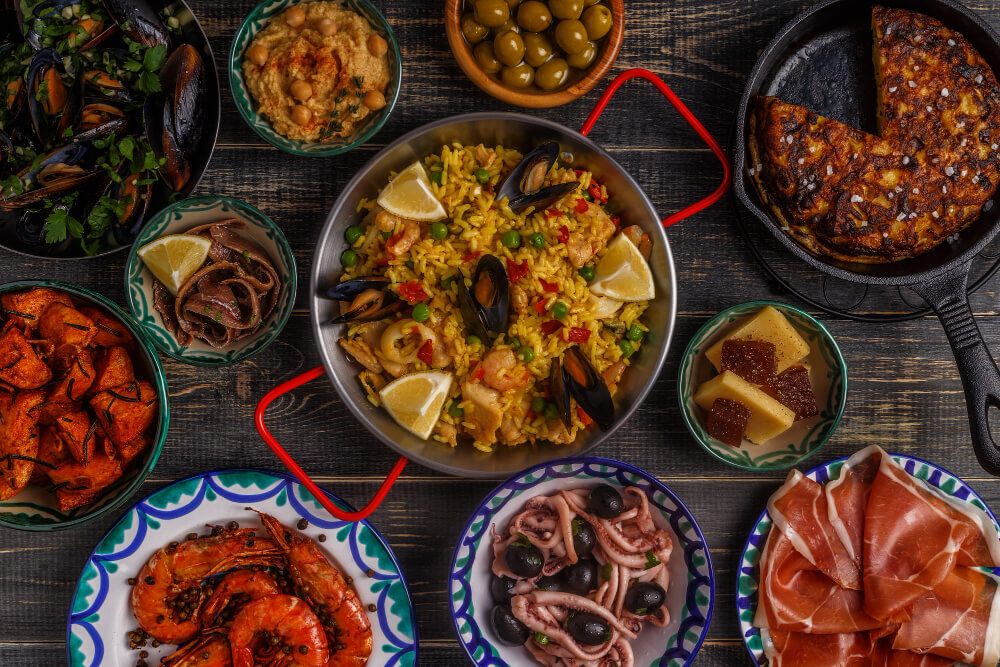Have you ever found yourself staring at a Spanish menu, wishing you could confidently order more than just “tacos” or “paella”? Understanding food vocabulary is one of the most practical and enjoyable ways to dive into Spanish language learning.
At Explore! Spanish Language Tutors, we’ve seen how food-related conversations create natural, engaging learning opportunities for our students in Cary, NC. Whether you’re planning a trip to a Spanish-speaking country or want to explore local Latin cuisine, mastering food vocabulary will enhance your language journey and cultural understanding. Ready to expand your Spanish food vocabulary? Contact us at 1-919-877-6832 to start your personalized language journey.
Basic Food Groups in Spanish
Fruits and Vegetables (Las frutas y verduras)
Learning produce terms opens doors to authentic experiences at local markets and restaurants. Start with everyday items like “manzana” (apple), “plátano” (banana), and “tomate” (tomato). When shopping, you’ll frequently encounter “fresco” (fresh) and “maduro” (ripe). Remember that vegetable names often differ between Spanish-speaking regions – what’s “palta” in Chile is “aguacate” in Mexico.
For seasonal shopping, learn terms like “temporada” (in season) and “orgánico” (organic). Vegetable-specific phrases such as “verduras de hoja verde” (leafy greens) and “tubérculos” (root vegetables) help you navigate produce sections with confidence.
Meat and Fish (La carne y el pescado)
Meat terminology varies significantly across Spanish-speaking cultures. Common cuts include “pechuga” (chicken breast), “lomo” (tenderloin), and “costillas” (ribs). Seafood enthusiasts should know “pescado” (fish), “camarón” (shrimp), and “atún” (tuna).
Understanding cooking preferences is crucial: “poco hecho” (rare), “término medio” (medium), and “bien cocido” (well done). For those with dietary restrictions, learn phrases like “No como carne roja” (I don’t eat red meat) or “Soy pescetariano/a” (I’m pescatarian).
Grains and Staples (Los granos y básicos)
Foundation foods form the backbone of Spanish cuisine. “Pan” (bread) comes in varieties like “pan integral” (whole wheat bread) and “pan dulce” (sweet bread). “Arroz” (rice) and “frijoles” (beans) are staples throughout Latin America, while “pasta” terms mirror Italian influences in Spanish cuisine.
Learn to distinguish between different grains: “quinoa,” “avena” (oats), and “cebada” (barley). Understanding these basics helps you discuss nutrition and daily meals naturally.
Kitchen and Cooking Terms
Essential Cooking Verbs
Mastering basic cooking verbs enhances recipe comprehension and kitchen conversations. Key actions include “cortar” (to cut), “hervir” (to boil), and “hornear” (to bake). More specific techniques include “saltear” (to sauté), “marinar” (to marinate), and “gratinar” (to broil).
Time-related cooking terms are equally important: “precalentar” (preheat), “cocinar a fuego lento” (cook on low heat), and “dejar reposar” (let rest). These terms help you follow cooking instructions and share family recipes.
Kitchen Utensils and Equipment
Navigate kitchen discussions with terms like “sartén” (frying pan), “olla” (pot), and “cuchillo” (knife). More specialized equipment includes “batidora” (mixer), “procesador de alimentos” (food processor), and “rallador” (grater).
Understanding proper usage requires prepositions: “en el horno” (in the oven), “sobre la estufa” (on the stove), and “dentro del refrigerador” (inside the refrigerator).
Measurements and Quantities
Learn numerical expressions alongside measurement terms like “cucharada” (tablespoon), “taza” (cup), and “pizca” (pinch). Master fractional measurements: “medio” (half), “un cuarto” (quarter), and “tres cuartos” (three-quarters).
Temperature measurements differ between countries using Celsius versus Fahrenheit. Learn both systems: “180 grados centígrados” (180 degrees Celsius) equals “350 grados Fahrenheit.”
Restaurant Vocabulary
Ordering With Confidence
Move beyond basic ordering with phrases like “¿Me puede recomendar…?” (Can you recommend…?) and “¿Cuál es la especialidad?” (What’s the specialty?). Learn to express preferences: “picante” (spicy), “sin sal” (without salt), or “término medio” (medium).
Handle special requests confidently: “¿Podría sustituir…?” (Could you substitute…?) or “¿Tiene opciones vegetarianas?” (Do you have vegetarian options?).
Menu Navigation
Learn course names like “entrada” (appetizer), “plato principal” (main course), and “postre” (dessert). Understanding cooking methods such as “a la parrilla” (grilled), “al horno” (baked), and “frito” (fried) helps you choose dishes that match your preferences.
Menu descriptions often include sauce terms: “en su jugo” (in its own juice), “a la crema” (in cream sauce), or “con salsa de…” (with… sauce).
Payment and Service
Master practical phrases like “la cuenta, por favor” (the check, please) and understand tipping customs in different Spanish-speaking countries. Learn to handle issues: “Hay un error en la cuenta” (There’s an error in the bill) or “¿Acepta tarjetas de crédito?” (Do you accept credit cards?).
Cultural Notes and Regional Differences
Spanish food vocabulary reflects rich cultural diversity. Lunch (“almuerzo”) in Spain might be at 2:00 PM, while in Mexico it’s earlier. Regional terms add depth to your language skills – “jugo” in Mexico becomes “zumo” in Spain.
Understanding meal customs helps navigate social situations. “Sobremesa” (after-meal conversation) is an important cultural concept in many Spanish-speaking countries.
Practice Tips and Real-World Applications
Enhance your learning by:
- Labeling items in your kitchen
- Following Spanish cooking videos
- Reading Spanish recipes
- Practicing at local Spanish restaurants
- Using food-related apps and games
- Joining cooking classes taught in Spanish
- Participating in language exchange meals
Regular practice transforms vocabulary into natural conversation. Try describing your daily meals in Spanish or discussing favorite recipes with language partners.
Conclusion
Building your Spanish food vocabulary opens doors to authentic cultural experiences and meaningful conversations. At Explore! Spanish Language Tutors, we’re passionate about helping you develop practical language skills that enrich your daily life. Whether you’re planning a trip abroad or want to connect with Spanish-speaking communities at home, mastering food vocabulary creates countless opportunities for genuine interaction.
Ready to enhance your Spanish language skills? Contact us at 1-919-877-6832 for personalized tutoring that incorporates these practical vocabulary lessons into your learning journey. Let’s make your Spanish language adventure both educational and delicious!




